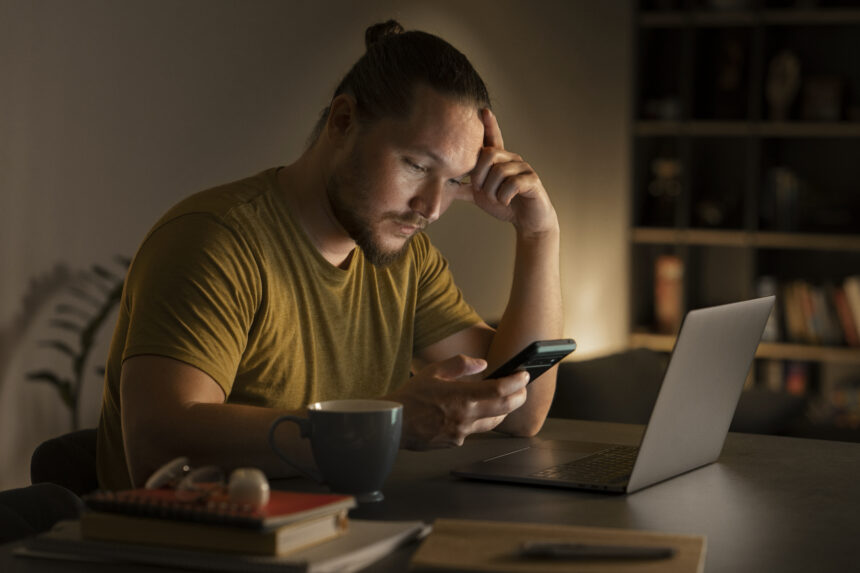The digital age has brought incredible convenience, from instant communication to endless entertainment. But as our screen time skyrockets, so do the mental and physical consequences of screen fatigue—a condition marked by exhaustion, stress, and decreased cognitive function due to excessive screen exposure.
With smartphones, laptops, and tablets dominating our daily lives, many people struggle to find balance between technology and mental well-being. This article explores the impact of screen fatigue on mental health, its symptoms, and practical strategies to reclaim control over digital consumption.
Understanding Screen Fatigue
What is Screen Fatigue?
Screen fatigue, also known as digital fatigue or screen burnout, refers to the mental and physical exhaustion caused by prolonged exposure to digital screens. It often results in:
- Mental fog and reduced concentration
- Eye strain and headaches
- Irritability and anxiety
- Sleep disturbances
The average adult spends 7-10 hours a day on screens, whether for work, social media, or entertainment. The more time we spend glued to devices, the greater the impact on mental wellness.
How Screen Fatigue Affects Mental Health
- Increases stress and anxiety: Constant notifications, emails, and social media updates keep the brain in a state of alert, leading to chronic stress.
- Reduces attention span: Studies show that excessive screen use rewires the brain, making it harder to focus for long periods.
- Disrupts sleep cycles: Blue light from screens suppresses melatonin, making it difficult to fall asleep and maintain restful sleep.
- Promotes social isolation: While digital interactions are convenient, they lack the depth of face-to-face conversations, leading to feelings of loneliness.
Signs You’re Experiencing Screen Fatigue
Wondering if you’re suffering from screen fatigue? Here are some telltale signs:
Physical Symptoms
- Eye strain (dry, red, or watery eyes)
- Frequent headaches or migraines
- Neck, shoulder, and back pain from poor posture
- Increased sensitivity to light
Mental & Emotional Symptoms
- Reduced focus and attention span
- Mental exhaustion or brain fog
- Irritability, stress, or anxiety
- Decreased motivation and productivity
Social & Behavioral Symptoms
- Doomscrolling (endless scrolling without purpose)
- Neglecting hobbies and real-world activities
- Feeling disconnected from friends and family
- Checking your phone compulsively even when unnecessary
If any of these symptoms sound familiar, it’s time to take action to break free from digital exhaustion.
Strategies to Overcome Screen Fatigue and Improve Mental Wellness
a) Follow the 20-20-20 Rule
To reduce eye strain, use the 20-20-20 rule: Every 20 minutes, look at something 20 feet away for at least 20 seconds. This gives your eyes a much-needed break from the screen.
b) Set Screen Time Limits
Most smartphones have screen time tracking tools that let you:
- Monitor daily screen usage
- Set app time limits (especially for social media)
- Schedule screen-free hours to unplug
Reducing unnecessary screen exposure can help you reconnect with real-life activities.
c) Prioritize Digital Detoxes
A digital detox doesn’t mean abandoning technology completely. Instead, it means taking intentional breaks to reset your mind. Try:
- A screen-free weekend (no phone, laptop, or TV)
- No screens after 8 PM to improve sleep quality
- Unplugging for an hour daily for relaxation
Even small detoxes can significantly improve mental clarity and emotional well-being.
d) Improve Screen Ergonomics
Bad posture while using screens can worsen fatigue. To reduce strain:
- Adjust screen brightness to match ambient light
- Use blue light filters or wear blue light glasses
- Maintain good posture—keep the screen at eye level
- Use a standing desk or ergonomic chair to avoid back pain
Better ergonomics help reduce physical discomfort and make screen time more manageable.
e) Be Mindful of Social Media Use
Social media is a double-edged sword—while it connects us, it can also lead to comparison, anxiety, and stress. To create a healthier relationship with social media:
- Unfollow accounts that trigger negativity
- Limit scrolling time to avoid mindless browsing
- Engage in real-life conversations instead of relying on digital interactions
Taking control of your social media habits can greatly improve mental well-being.
f) Make Sleep a Priority
Good sleep hygiene is essential for fighting screen fatigue. To improve sleep:
- Avoid screens at least 1 hour before bed
- Use night mode to reduce blue light exposure
- Create a bedtime routine (reading, meditation, or listening to calming music)
- Keep devices out of the bedroom to prevent late-night scrolling
Better sleep = better mood, focus, and overall mental health.
g) Reconnect with Offline Activities
One of the best ways to reduce screen time is to rediscover real-world experiences. Consider:
- Reading physical books instead of digital ones
- Practicing mindfulness or meditation to relax the mind
- Spending time in nature to reduce stress
- Engaging in face-to-face social interactions instead of texting
Finding joy outside the digital world helps restore mental balance and well-being.
4. The Future of Mental Wellness in a Digital World
Technology isn’t going anywhere, and neither are screens. The challenge is learning how to use digital tools responsibly without compromising mental health.
What Can We Expect?
- More focus on digital well-being tools – Tech companies are introducing features to track screen time and encourage breaks.
- Rise of AI-driven mindfulness apps – Apps like Headspace and Calm use AI to provide personalized mental wellness recommendations.
- More workplaces embracing digital wellness – Companies are adopting policies like “No-Email Fridays” and remote work flexibility to reduce screen fatigue.
- Greater awareness of the mental impact of technology – Society is beginning to recognize the importance of disconnecting to recharge.
The key is to find a balance—leveraging technology for its benefits while maintaining control over screen time.
Final Thoughts: Taking Control of Your Digital Life
In the digital age, mental wellness depends on how we manage technology. Screens are an essential part of life, but we don’t have to let them control us.
By setting healthy boundaries, practicing digital mindfulness, and prioritizing offline experiences, we can break free from screen fatigue and create a healthier, more balanced lifestyle.
Remember: Technology should enhance life, not consume it.
FAQs
1. How much screen time is too much?
Experts recommend limiting non-work screen time to under 3-4 hours daily to prevent screen fatigue.
2. Does blue light really affect sleep?
Yes, blue light suppresses melatonin production, making it harder to fall asleep and reducing sleep quality.
3. Can screen fatigue cause anxiety?
Yes, excessive screen use can contribute to stress, anxiety, and even depression, especially when combined with social media overuse.
4. What’s the best way to do a digital detox?
Start small—try a 1-hour screen-free break daily, then gradually increase screen-free time to weekends or full days.
5. How can I balance work and screen time?
Use the 20-20-20 rule, take regular breaks, and set “screen-free” hours after work to reduce fatigue.





